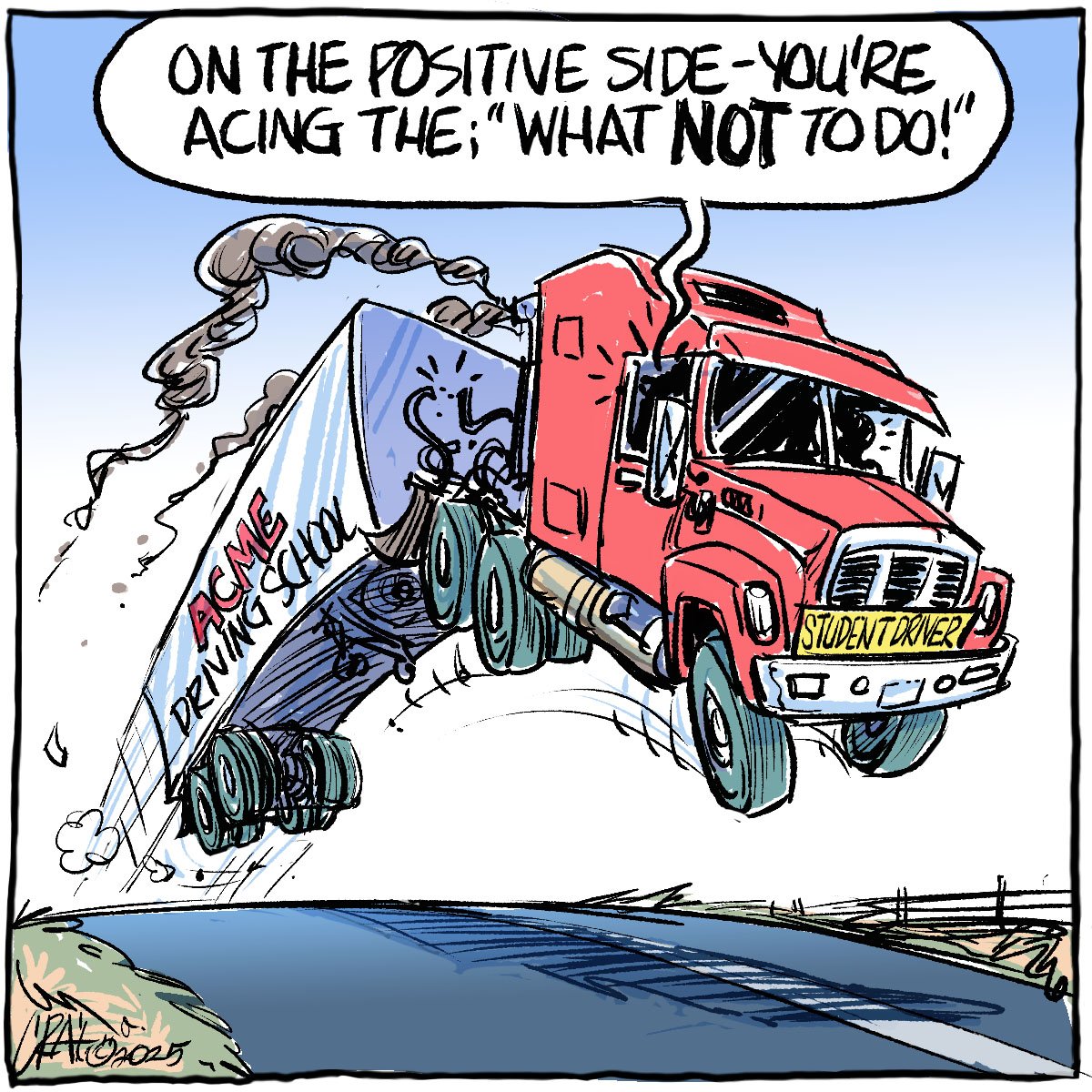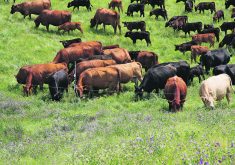Market freedom
Producers in all regions of Canada require a system that allows us to take advantage of producer-owned, value-added processing plants. Right now it is impossible in the designated area called the Canadian Wheat Board (to) add value to your crop.
Remember, value is not in exporting the raw commodity. The value is in the processing of the raw commodity, which we are entirely missing out on under the dictatorship of the CWB.
Many farmers do not want to see the end of the CWB. They want choice when marketing their wheat and barley. For the CWB to say that they must have a total monopoly in order to survive just shows their incompetence and lack of vision.
Read Also

Efforts to improve trucking safety must be applauded
The tragedy of the Humboldt Broncos bus crash prompted calls for renewed efforts to improve safety in the trucking industry, including national mandatory standards.
I would like to give you a couple of examples of where co-operatives compete. Federated co-ops go head to head with the world’s largest retailers and also with the largest fuel companies. Credit unions compete against the largest financial institutions in the world, and in both examples they succeed in a competitive environment.
Farmers deserve the right to choose who, where and how they market their wheat and barley. This is a democratic right that should have never been taken from us. Every producer should be working hard to get this freedom back….
In the March 27 issue of The Western Producer, Bev Currie tied the CWB to the egg, chicken, turkey boards, etc. I would like to explain that the CWB has nothing to do with supply management. It does not control production. It doesn’t control imports from offshore. It does not have a formula built in to add value to the producer when expenses move upward. Supply management is national in scope, while the CWB is regional.
The comparison between the CWB and supply management has been drummed up by the CWB to instill fear for their political purposes.
The CWB does not return a premium for our own wheat and barley to my farm. The fact is, I would do far better in a free, competitive, open market, with the CWB being one of the choices.
It is time that the federal government moves forward in giving all western Canadian wheat and barley producers marketing freedom.
– Charles Anderson,
Rose Valley, Sask.
Winners & losers
The debate surrounding the Canadian Wheat Board continues and is growing confrontational. The main discontent for the anti-wheat board supporters is that they cannot market their grain wherever they want.
That may be an individually fair statement but is it in the best interest of the whole farming community?
There would be winners and losers if the wheat board ceased to exist. Large farmers and those in close proximity to the end users would be the winners, not to mention the speculators, grain companies and the domestic end users. Most farmers, who need the ability to centrally sell their grain to remain competitive, would be the losers. As long as we remain an exporting nation we need to be united as farmers in the world market….
Three years ago, my son and I went to contract our flax. In the time it took to write up my son’s contract and then mine, the price had dropped 12 cents per bushel.
Lately, we thought we would lock in another 25 percent of our fall canola crop. The open market radio broadcast had the canola price at $555 per tonne. When we phoned the elevator we found they had raised the basis to $100 per tonne, over $2 a bu. less.
Speculators buy contracts, artificially raising prices. Then they sell to “profit take,” lowering the price. …
Some producers claim they have lost thousands of dollars by not being able to sell their grain into spot markets but the same can be said for the thousands of dollars we lose when we have to sell grain for cash flow, then watch helplessly as the price increases all winter. …
If the American open market system is so wonderful why are they among the world leaders in farm subsidies?
The CWB has worked hard, on our behalf, over the decades to establish the western Canadian farmer as reliable supplier of a consistent, top quality product in the world market. Why would we risk losing that?…
– Garry Draper,
Lenore, Man.
100 miles
A recent article by the Western Canadian Wheat Growers Association proposes the 100-mile farm. Some consumers have recently adopted the 100-mile diet, an undertaking to eat only food grown within 100 miles….
That is a commendable idea given the benefits of local economic development and the high costs, both economic and environmental, of transporting goods long distances. However, we should consider what else we might be expected to give up in order to achieve that.
A dozen years ago the WCWGA was among those leading the charge to dismantle the Western Grain Transportation Act. With the WGTA gone, they promised, the Prairies would flourish. Millers, crushers, packers, and processors of all kinds would set up shop here….
Truth be told, that dream lost more than a little of its grandeur in coming true. A quick scan of the current prairie skyline reveals that the most significant outcome of that exercise is the 100-mile elevator.
– Jim Metherell,
Lashburn, Sask.
Grass-fed beef
The April 10 edition of The Western Producer had an article titled “True grass-fed cattle long gone: expert.”
I personally do not agree that these cattle are long gone and feel that a look around outside of his box will find some cattle that fit well in to the grass fed or short grain finish category. I personally raise Galloway and Welsh Black breeding stock and have selected for cattle that mature at a smaller size and finish at a lighter weight.
We sold a load of 56 fat cattle in February of this year. These were mostly heifers and the bottom end of the steers in the group. The steers went out in December with similar carcass results as follows. The heifers’ average age was about 20 months. Some were fed through the summer last year and the rest were grazed. All of the cattle were then placed on a 50 percent start up and 65 percent maximum finishing ration.
Lakeside Packers at Brooks was kind enough to bid on these cattle that were supposed to be destined for our hormone-free marketing program, which was over supplied. They sent me back the weights and grading results.
The average weight of these carcasses was 623 pounds. The steers that went out in December at about 18 months weighed an average of 669 on the hook. The heifers and bottom end steers sold in February saw 35 percent grade AAA and two came back as Prime.
I realize that you may even have a hard time printing this article as it may seem too much like an infomercial for Galloway and Welsh Black cattle….
Most producers have only heard of the weight gains on barley for the past 30 years and have also sat back and watched these premium cattle that I raise docked in the auction barns because the feedlot buyers don’t like the hair.
I won’t be letting that hair over my eyes grow any longer. How about you?
– Randy Kaiser,
Ponoka, Alta.
Deaf ears
Re: “Farmer’s behalf” (Open Forum, April 10) by Gerry Ritz.
Mr. Ritz, you say that the government has a bedrock principle: farmer’s first, you listen to us and work shoulder-to-shoulder with us and then deliver the results that we need, whether it’s referring to the CWB or any other farming issues.
All I can say is you listen to us with deaf ears and see our situation with blind eyes.
Did you see my reaction when I opened my fertilizer bill this past year, or hear my gasp when I saw my fuel bill? Not to mention my shock when I calculated how much my grain cheque went for freight charges. Or all the time, energy and care I put into raising healthy calves to sell.
Did you happen to see the cheque I got for all that work? I don’t think so, Mr. Ritz.
You and the government listen to us farmers about as well as when I tell my kids to keep their rooms clean. I hope you’re all enjoying your toast in the mornings and your steaks for supper. Need I say more?
– Sarka Kwasnycia,
Derwent, Alta.














